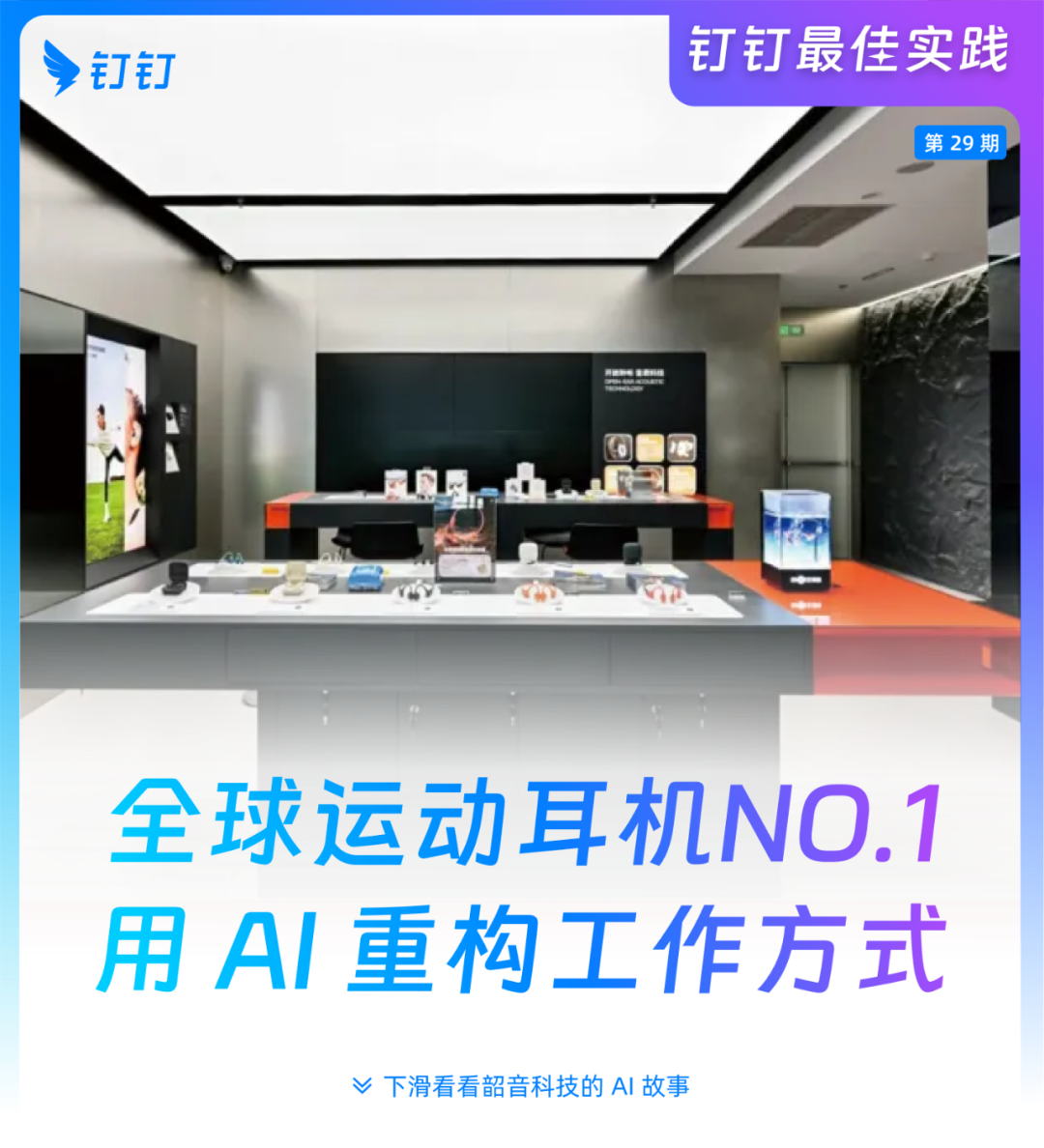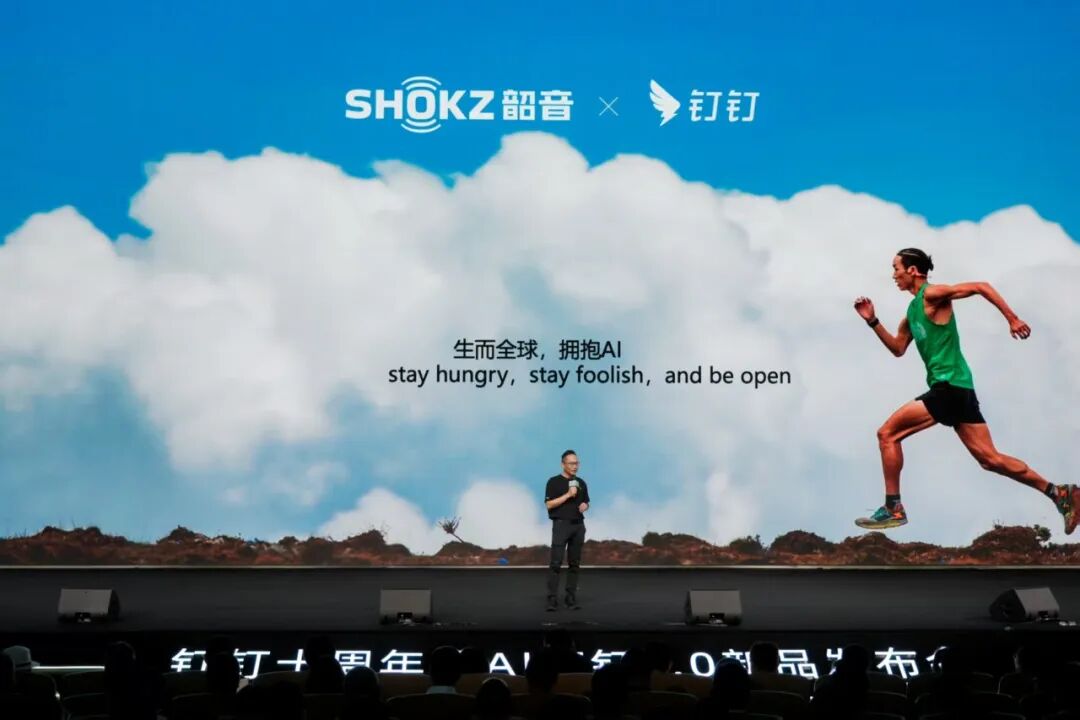
The Growth Path of a New Generation of Chinese Innovation:
Born global, grown with AI.

"We chose DingTalk mainly because it listens," said Chen Xiangshuai, CIO of Shokz Technology, at last month’s 10th anniversary product launch event for DingTalk. His words instantly resonated with the CIOs of major enterprises in attendance.
Recalling his first encounter with DingTalk back in 2019, Chen noted that the platform's meeting system wasn't as smooth as it is today, and AI had yet to become standard in collaborative office tools.
Today, for Shokz—a company inherently global from day one—operations are inseparable from DingTalk.
To the average Chinese consumer, "Shokz" might still be a niche brand.
But on the Boston Marathon course, you’d feel awkward greeting friends without a pair of Shokz headphones.
In 2012, Shokz made waves at the International Consumer Electronics Show (CES) with its self-developed bone conduction "black tech." Visitors queued up to try it out, and a front-page feature in The Wall Street Journal helped catapult Shokz into popularity across North America.
And Shokz has lived up to the hype.

In its early days, bone conduction headphones were considered almost counterintuitive. But after nine years of R&D and five generations of iteration, Shokz broke new ground by overcoming the four major technical hurdles in bone conduction: sound quality, sound leakage, power consumption, and vibration.
In 2024, Shokz topped global sales rankings for sports headphones, pulling far ahead of competitors.
In recent years, Shokz has seen sales grow over a hundredfold, with cumulative global sales surpassing 18 million units.
Its sales network spans more than 60 countries and regions; overseas teams are based in Singapore, Japan, North America, and beyond.
As Chen puts it:
"We're not an overseas expansion company—we’re a truly global company. Our brand was built abroad and then brought back home."
Rapid global expansion and explosive growth prompted Shokz to initiate deep digital transformation in 2019.
An organization’s collaboration capability directly determines its operational effectiveness. For tech companies, meetings represent one of the most critical collaboration scenarios.
Shokz holds many meetings: cross-regional project development sessions, supply chain coordination meetings with external suppliers, internal strategy huddles, and global coordination calls with overseas colleagues—all demanding a mature and reliable cross-border meeting solution.
With over 150 meeting rooms across its global offices, Shokz upgraded all facilities using standardized interior design and hardware specifications after adopting DingTalk’s meeting system. Even screen-sharing during meetings maintains consistent branding across locations. From meeting screen projection and room booking management to partner meeting experiences, everything is now unified globally.
DingTalk Meetings also includes a hidden gem: real-time translation. When you speak Chinese from within China, your overseas colleagues see automatic English subtitles on their screens. When they reply in English, you receive accurate Chinese translations instantly.
The result? Simple and efficient pre-meeting scheduling, real-time AI-powered translation during meetings, and post-meeting AI-generated summaries and task lists.
From initial issues like lagging connections and inaccurate translations to seamless resolution—just like with bone conduction technology and globalization, where there were no precedents to follow—Shokz achieved unified global meeting operations through DingTalk.

Most Chinese tech innovators typically have an overseas counterpart they initially emulate before catching up and eventually surpassing them.
But Shokz has no such benchmark.
It is the global pioneer and leader in open-ear headphones and the only company with proven technical solutions to the four core challenges of bone conduction: sound quality, sound leakage, power consumption, and vibration.
In 2021, Shokz won China’s prestigious Patent Gold Award solely based on its patent titled “A Method for Reducing Sound Leakage in Bone Conduction Speakers and the Speaker Itself.”
Having filed over 5,000 patents—forming a formidable technological moat—Shokz faced a massive challenge in digital management:
How to ensure efficient knowledge transfer across departments while safeguarding core secrets?
With DingTalk, this dilemma finds resolution.
Previously, explicit and tacit knowledge struggled to flow efficiently, leading to inevitable inefficiencies.
For example, when a new employee returned from an overseas business trip needing reimbursement, they wouldn’t know how to proceed and would have to ask senior colleagues. Even those might not know, forcing them to consult finance or HR, drowning functional roles in routine inquiries.
From “how to fill out a travel expense form” to “how to calculate meal allowances abroad,” finance and HR staff spent their days repeating answers to similar questions—low efficiency and low perceived value.
In reality, this explicit knowledge should have been fully accessible and readily available, but instead it was fragmented across individuals’ and departments’ personal computers.
Trying to locate a cross-departmental document often meant asking the original person involved—otherwise, no one knew which version was current.
The barriers around tacit knowledge in technical teams were even worse, filled with “black boxes” and informal jargon understood only by insiders. When projects changed or personnel shifted, these black boxes couldn’t be opened, and the jargon became indecipherable—leading to helpless frustration.

The turning point came in 2024, when AI began being widely adopted within the enterprise.
Quickly, IT and HR teams collaborated to compile technical terms and department-specific jargon into DingTalk’s “Enterprise Encyclopedia.”
Employees soon discovered that mentioning a specialized term—like “module function verification”—in chats, documents, or group conversations allowed them to click and access instant explanations, rapidly grasping professional knowledge and business logic, boosting communication efficiency.
Encouraged by early success, employees formed “knowledge groups,” creating over 800 encyclopedia entries.
Departments including supply chain, R&D, HR, and marketing built structured knowledge systems based on this repository, deeply integrating knowledge with business operations.
The “Corporate Culture Team,” for instance, uploaded cultural materials so that new hires could find answers instantly via DingTalk search instead of asking around.
This thriving knowledge base caused Shokz’s DingDrive storage to surge from 5TB to 20TB in just one year.
The integration of DingTalk AI Assistant further solved the problem of “information that can’t be found.”
Before, searching for “meal allowance standards in a certain country” would fail if the database entry was labeled “Overseas Business Trip Standards” due to keyword mismatch.
But with the introduction of DingTalk AI Assistant, semantic understanding made searches instantaneous and accurate.
This combination of “knowledge base + AI” successfully broke down knowledge silos, becoming a powerful tool for cross-department collaboration.
Yet for any high-tech enterprise, information security remains paramount.
Recently, an internal data security incident left Chen deeply alarmed.
A trainee in one department downloaded large volumes of core technical documents before leaving the company. DingTalk’s security alert system detected the abnormal activity and immediately notified relevant departments.
Follow-up investigations revealed that some classified materials were included in the download.
Thanks to dual protection from both DingTalk and internal systems, a major data leak crisis was averted.
This experience demonstrated to Shokz the strength of DingTalk’s security capabilities—and showed how efficient knowledge sharing and precise access control can coexist harmoniously. This balance is precisely what enables true innovation in high-tech enterprises.

To many, using AI effectively seems to require high technical expertise.
But what mattered most to Shokz’s IT department was ensuring that actual business users—even frontline employees—could easily use DingTalk AI.
"AI must be placed in the hands of business teams. If IT tries to own AI, nothing meaningful will come out of it. Ultimately, AI should help solve real business problems."
In reality, as Shokz expanded globally and grew rapidly, the team hit hardest wasn’t engineering—it was HR.
Their biggest headache? Resume screening.
Initial resume screening used to be a quick “glance-and-pass” task. But with thousands of applications flooding in, HR teams found themselves spending excessive time on this seemingly minor chore.
Frustrated, the HR team approached IT to explore using DingTalk’s “AI Spreadsheet.”
After all, it was accessible right inside DingTalk—super convenient.
But early attempts failed: the AI’s screening accuracy was only 30%–50%, requiring manual rechecks and offering little efficiency gain.
So Chen led his team in a two-pronged effort: continuously feeding feedback to the DingTalk team while working closely with HR to refine prompt engineering and uncover patterns.
In July this year, breakthrough arrived.
With a major upgrade to DingTalk’s AI Spreadsheet, everyone suddenly noticed: the AI had “awakened.”
Now, after 15 iterations of optimized prompts, the AI’s resume screening accuracy jumped to 70%–80%.
Most importantly, the AI’s rejection decisions reached expected accuracy levels.
From then on, HR could let the AI complete preliminary screening of massive resume batches in seconds, focus human efforts on reviewing qualified candidates, and dedicate more energy to interviews—greatly improving overall efficiency.
But DingTalk’s AI Spreadsheet went even deeper.
Previously, at one Shenzhen office, property security guards conducted safety inspections after 8 p.m. daily. But their usual process involved only verbal reports or filling paper forms later converted into Excel sheets—lacking rigor and timeliness.
Sometimes hazards were observed but forgotten upon return; other times, the Excel entry missed location details. Worse, even if recorded, it often turned into mere formalism. There was no proof of fixes, no follow-up checks. If anything went wrong, finger-pointing ensued.
They quickly devised a solution using DingTalk AI Spreadsheet: take photos and upload them directly. The AI automatically identifies issues and triggers workflows, assigning tasks and tracking progress—all within a single shared spreadsheet.
Once launched, the guards loved it.
Now, if a guard spots a broken fire hydrant, they simply snap a photo. The AI recognizes the issue, automatically initiates the workflow, assigns it to the responsible party, and tracks resolution in real time.
Today, Shokz employees have developed over 700 AI assistants on DingTalk, making it easy for ordinary staff to adopt and use.
Shokz’s “DingTalk + AI” innovation reaches deep into R&D labs and extends down to frontline workers, transforming into a productivity tool that everyone can use comfortably and effectively.

From HR to knowledge management, from physical security to digital safeguards, from connecting China to communicating globally—Shokz’s journey reflects the broader story of a new generation of Chinese tech innovators.
Their technology impresses the world; their brand spans the globe; their innovation is infused with AI at every level.
“Born global,” Shokz is emerging as a new model for technological innovation among Chinese enterprises.

We dedicated to serving clients with professional DingTalk solutions. If you'd like to learn more about DingTalk platform applications, feel free to contact our online customer service or email at
Using DingTalk: Before & After
Before
- × Team Chaos: Team members are all busy with their own tasks, standards are inconsistent, and the more communication there is, the more chaotic things become, leading to decreased motivation.
- × Info Silos: Important information is scattered across WhatsApp/group chats, emails, Excel spreadsheets, and numerous apps, often resulting in lost, missed, or misdirected messages.
- × Manual Workflow: Tasks are still handled manually: approvals, scheduling, repair requests, store visits, and reports are all slow, hindering frontline responsiveness.
- × Admin Burden: Clocking in, leave requests, overtime, and payroll are handled in different systems or calculated using spreadsheets, leading to time-consuming statistics and errors.
After
- ✓ Unified Platform: By using a unified platform to bring people and tasks together, communication flows smoothly, collaboration improves, and turnover rates are more easily reduced.
- ✓ Official Channel: Information has an "official channel": whoever is entitled to see it can see it, it can be tracked and reviewed, and there's no fear of messages being skipped.
- ✓ Digital Agility: Processes run online: approvals are faster, tasks are clearer, and store/on-site feedback is more timely, directly improving overall efficiency.
- ✓ Automated HR: Clocking in, leave requests, and overtime are automatically summarized, and attendance reports can be exported with one click for easy payroll calculation.
Operate smarter, spend less
Streamline ops, reduce costs, and keep HQ and frontline in sync—all in one platform.
9.5x
Operational efficiency
72%
Cost savings
35%
Faster team syncs
Want to a Free Trial? Please book our Demo meeting with our AI specilist as below link:
https://www.dingtalk-global.com/contact

 English
English
 اللغة العربية
اللغة العربية  Bahasa Indonesia
Bahasa Indonesia  Bahasa Melayu
Bahasa Melayu  ภาษาไทย
ภาษาไทย  Tiếng Việt
Tiếng Việt 